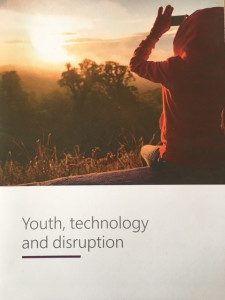Youth, Technology & Disruption
 This week, Microsoft New Zealand released a whitepaper entitled Youth, Technology & Disruption that examines the situation young people face in New Zealand when it comes to education and future work opportunities.
This week, Microsoft New Zealand released a whitepaper entitled Youth, Technology & Disruption that examines the situation young people face in New Zealand when it comes to education and future work opportunities.
There are a number of points in the whitepaper and you can read the original copy by clicking here, with Managing Director of Microsoft NZ Barrie Sheers drawing attention to the following three:
- Microsoft believes all students must be taught tech skills and have an opportunity to learn computational thinking.
- Microsoft have called on the government to urgently make the necessary investments to achieve this – and to ensure that no students are left behind.
- Microsoft also want to see greater industry involvement with government officials to ensure what students are taught reflects what the industry needs.
Whilst I work for Microsoft now, my previous role was as the Director of ICT at an Independent School in New Zealand so I was very interested to read this paper in detail. I went over it and made a number of highlighter marks and you can see my own take on what stood out by clicking here.
The paper rightly touched on the teacher shortage in the area of Digital Technologies curriculum in New Zealand, but also the need to up-skill existing teachers in other curriculum areas to be able to teach computational thinking skills. In my visits to schools over the last two weeks I’ve already come across two secondary schools that were either already teaching this, or had firm plans to have a course on computational thinking for 2017. The whitepaper defines computational thinking as:
Computational thinking is about looking at a problem and knowing how to utilise a computer help solve it. It is a two step process:
- First, we think about the steps needed to solve the a problem
- Second, we use technical skills to get the computer working on the problem
[caption id="attachment_268" align="aligncenter" width="584"] Image taken from the whitepaper – see the original link above[/caption]
The whitepaper highlights the role that technology is playing as a disruptive influence in all areas of life, accelerating the pace of change like never before. I know a number of schools invested significantly in the cost of sending staff to the Singularity University NZ Summit held in Christchurch in November 2016 . Having talked with teachers from the schools that attended this, I am aware just how much the information in this whitepaper aligns with the messages from that conference. What stood out to me is that whilst it may seem obvious there will be increasing demand for skilled and educated workers in the technology sector, the majority of people using technology as a significant part of their work role, will be outside of what is traditionally understood to be the technology sector.
For that reason, the need to get all students capable of thinking computationally and understanding how best to utilize technology is critical and schools need to be tackling this challenge head on. There are some scary stats in the whitepaper too: a 2015 report commissioned by the Accountants of Australia and New Zealand found:
46% of the NZ work faces a high risk of computerisation. That’s 885,000 workers who will find their jobs automated over the next 20 years
To this end, the future will see workers who are either “tech users” or “tech creators” and the whitepaper talks in detail about the skills sets required for our students of today to be prepared for that future. Pleasingly, when taught well, computational thinking teaches other key skills from the NZ Curriculum’s “Key Competencies” including collaboration, communication, problem solving, literacy and numeracy.
[caption id="attachment_288" align="aligncenter" width="584"] The pathway through NZ Schooling for Tech Users and Tech Creators – see the full whitepaper via the link at the top of the blog post[/caption]
The whitepaper concludes with the following quote:
The future we are all looking at is one coloured and shaped by technology. This means that while not everyone sees a future for themselves in the technology industry, whatever industry a young person chooses to work in will have a technology component.
For ākonga (students), kura (schools) and whānau (family) in New Zealand the message in unequivocal – start to think and understand the role of technology and how it will be an influencer on future education and work endeavours. This whitepaper is a good starting point and a call to action for the NZ Education sector, and I encourage you to read it in detail by clicking here.